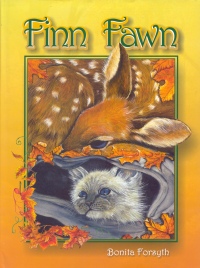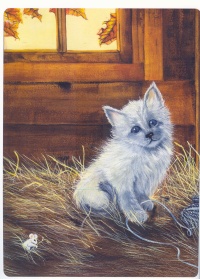| ________________
CM . . .
. Volume XX Number 5. . . .October 4, 2013
excerpt:
Written and illustrated by Bonita Forsyth, Finn Fawn is a rhyming picture book about a little deer on an adventure to find his mother. It is the fifth in the “Huckleberry Hollow” series but can be enjoyed on its own.
Finn Fawn is rich in autumn-toned colours, with a myriad of two-page spreads. Many of the watercolour paintings are very detailed: look out for a little mouse named Nibbles and for the good luck fairy whose face appears when the animals are in danger. The inside cover has a map of Huckleberry Hollow where readers can use their imaginations to follow Finn’s journey. There are a couple of particularly lovely illustrations worthy of a framed spot in a child’s bedroom. Unfortunately, there are a few elements that weaken the book. Forsyth attempts to use verse, but the metre is sporadic, and some of the rhymes are forced, thus creating a clunky feel to the third-person narration. There was also an apostrophe typo on the map. Finally, Shaggy is not painted consistently. Just one example is that the kitten is nearly half as long as the canoe in an illustration. At the end of the book, Forsyth offers readers an “Interesting Facts on Fawns” page. For instance, a mother deer moves away from her young for its first days in order to prevent her scent from attracting predators (this is referred to in the story): she is near enough only to watch and feed her young. This facts page adds a pleasing, educational finish to the story. Finn Fawn is a gentle story that best lends itself to young children. Recommended with reservations. Ottawa, ON, based Gwen Smid is a teacher, a writer, and – like Shaggy – a canoeist (although she hasn’t fallen over any waterfalls).
To comment
on this title or this review, send mail to cm@umanitoba.ca.
Copyright © the Manitoba Library Association. Reproduction for personal
use is permitted only if this copyright notice is maintained. Any
other reproduction is prohibited without permission.
NEXT REVIEW |
TABLE OF CONTENTS FOR THIS ISSUE
- October 4, 2013.
AUTHORS |
TITLES |
MEDIA REVIEWS |
PROFILES |
BACK ISSUES |
SEARCH |
CMARCHIVE |
HOME |

 The story opens with Finn’s birth, and readers learn about the protective relationship between a doe and her fawn. Shaggy, the kitten, is soon introduced: a cat who likes to go on canoe rides with his human friend. The action crescendos as Shaggy – alone in the canoe – drifts downstream and over a waterfall. While the kitten hides from an eagle, Finn Fawn has become lost, and the two frightened little souls band together for support, especially as it starts to snow. In the morning, they reach Shaggy’s home where Finn stays for weeks in a barn. Finally, Shaggy’s human friend puts Christmas lights on the barn to show Finn’s mother where her fawn is staying, and the deer family is reunited.
The story opens with Finn’s birth, and readers learn about the protective relationship between a doe and her fawn. Shaggy, the kitten, is soon introduced: a cat who likes to go on canoe rides with his human friend. The action crescendos as Shaggy – alone in the canoe – drifts downstream and over a waterfall. While the kitten hides from an eagle, Finn Fawn has become lost, and the two frightened little souls band together for support, especially as it starts to snow. In the morning, they reach Shaggy’s home where Finn stays for weeks in a barn. Finally, Shaggy’s human friend puts Christmas lights on the barn to show Finn’s mother where her fawn is staying, and the deer family is reunited.